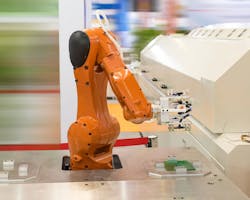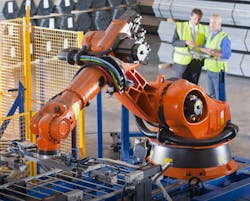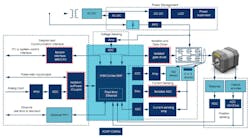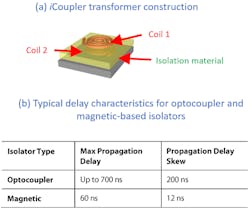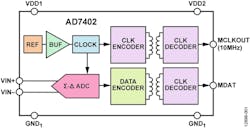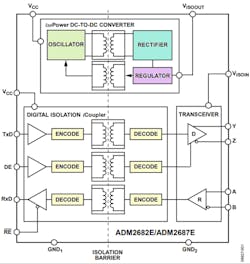Isolation—An Integral Component in Robotics Motion Control
Download this article in PDF format.
The transition to Industry 4.0 has accelerated the adoption of robots, cobots (cooperative robots that interact with humans in a common workspace), and other advanced machines on the factory floor to generate higher levels of productivity. In addition, new energy standards are demanding ever-increasing levels of power efficiency.
Together, these new requirements drive new design challenges in several areas, including networked communications, distributed sensing, and precision motion control.
Sponsored Resources:
- AD7402/AD7403/AD7405 Sigma-Delta Modulators
- Analog Devices Motor Control Solutions
- ADUM4223 / ADUM3223 Half-Bridge Driver
The Motor and its Control System: Critical Factors in Energy Reduction
A current-generation factory work cell, such as the industrial robot shown in Figure 1, uses multiple electric motors. In fact, electric motors account for around two-thirds of industrial power consumption according to some studies. Thus, it’s no surprise that developing power-efficient motors and control strategies is of paramount importance.
1. Robots and other Factory 4.0 applications require both precision motor control and low energy consumption. (Source: Analog Devices)
Several motor technologies are used on the factory floor: brushed dc (BDC) and brushless dc (BLDC), ac induction, stepper, servo, and more. In dc motors, the BLDC motor is preferred over the BDC motor because it has higher efficiency, higher torque-to-weight ratio, higher reliability, and lower noise.
The BLDC motor also requires less maintenance, but there’s one disadvantage: It needs a more complex and expensive controller. A BDC design has a permanent-magnet stator and relies on mechanical commutation of a wound rotor; a BLDC reverses the arrangement, with a wound stator and a permanent-magnet rotor.
As a result, a BLDC requires electronic commutation. The controller must energize the stator windings in a specified sequence to maintain rotation of the rotor assembly. Accomplishing this requires knowing the rotor position. A rotor-mounted sensor can provide the information directly, or the controller can calculate it based on the voltages and currents in the phase windings.
The BLDC motor-control system typically also includes a power-management block, a human-machine interface (HMI), a means of hooking into the factory network, and perhaps an interface to a programmable logic controller (PLC). Figure 2 shows the system block diagram with its diverse set of functional blocks. ADI products are shown in dark blue.
2. A robot motor-control system includes several isolated blocks, highlighted in red. (Source: Digi-Key)
Isolation’s Key Role in Industrial Motor-Control Design
Fig. 2 includes several ADI devices, highlighted in red, that combine isolation with a standard analog or digital function. Galvanic isolation—isolating functional sections of electrical systems to prevent current flow between them—is a critical requirement of many industrial designs.
An isolated device prevents the propagation of dc and unwanted ac currents between input and output while passing the desired signal. It accomplishes this using an isolation barrier that has a high breakdown voltage and low leakage. No resistive path exists across the isolation barrier, but the device can still transfer information across it using capacitive, inductive, or optical techniques.
There are several reasons for isolating sections of a design. Safety is one, to protect operators and other pieces of equipment from the high voltages and currents present in many industrial operations.
Functional isolation solves non-safety-related problems. For example, the ground reference level can vary widely between two separate electrical systems in an industrial plant. This difference can lead to errors in a digital transmission. In an analog circuit, any dc ground difference between devices adds an unwanted offset error; an ac variation can affect the harmonic content of the signal. Adding an isolation device to a circuit can correct for such ground differences.
In some applications, a low-level signal of interest may ride on a larger common-mode (CM) voltage. This voltage can be greater than the full-scale range of a downstream device or exceed its overvoltage limits and cause damage. An isolation device can block the common-mode voltage and make sure that only the signal to be measured passes across the isolation barrier. The downside is that adding isolation to a non-isolated design tends to increase system cost, increase power consumption, and decrease the data-transfer rate.
As a leader in analog, mixed-signal, and digital-signal-processing (DSP) integrated circuits, Analog Devices Inc. (ADI) offers many isolated products suitable for different parts of the motor-control signal chain: isolated gate drivers; isolated sense circuits such as op amps and analog-to-digital converters (ADCs); and isolated communications devices such as RS-485 transceivers.
There are several technologies available to transfer information across an isolation barrier. Optical isolation—converting the electrical signal to light with a light-emitting diode (LED) and transmitting the light pulses to a photodetector across a gap filled with mold compound—has long been a popular option. However, the performance of the optocoupler changes over time as the LED ages. In addition, parasitic capacitances provide an unwanted coupling mechanism that degrades the common-mode transient immunity (CMTI).
ADI’s iCoupler technology uses chip-scale transformers to transfer high-speed digital data across the barrier via magnetic induction. An iCoupler transformer (Fig. 3) incorporates two coils separated by isolation layers of polyimide or silicon dioxide (SiO2). The symmetrical nature of the transformer structure allows for common processing blocks with advanced encode-decode schemes, resulting in faster, more consistent operation and the option of bidirectional data transfer.
3. The iCoupler chip-scale transformer (a) results in superior propagation delay and skew (b) versus optical isolation. (Source: Analog Devices)
As shown in Fig. 3, the iCoupler transformer technology delivers lower propagation delay and skew than an optocoupler-based isolator. This is important for motor-control designers because they can reduce the margin of error due to gate-driver variations. It allows them to reduce the dead time, leading to lower distortion of the motor output voltage. The result is less vibration during low-speed operation, less torque ripple, and less energy wasted as heat.
ADI isoPower devices combine isolated signal transfer with isolated power delivery. The power microtransformer switches at up to 300 MHz for high efficiency. Even so, an isoPower device emits very little EMI—less than 500 pW at 300 MHz—due to the small radius (~0.5 mm) of the transformer.
Functional Blocks of a Motor-Control System
We will review the primary functional blocks of the BLDC control system and spotlight several ADI products that help designers add the isolation function.
The motor driving block drives each of the three phase windings independently. It typically consists of six gate drivers driving six power transistors configured as three half-bridges. The power transistors can be silicon IGBTs (insulated gate bipolar transistors) or MOSFETs (metal-oxide-semiconductor field-effect transistors), but the drive toward higher efficiency is increasing the adoption of wide-bandgap (WBG) power switches using SiC (silicon carbide) or GaN (gallium nitride).
WBG power switches have extremely low switching losses compared to silicon. As a result, they’re very efficient but impose stringent demands on the gate drivers. Analog Devices’ isolated gate drivers are designed for these higher switching speeds, while still providing reliable control over MOSFETs and IGBTs.
The ADuM3223/ADuM4223 half-bridge gate drivers employ iCoupler technology to provide independent and isolated high-side and low-side outputs. The devices can supply 4-A peak output current and operate at up to 1 MHz. The ADuM3223 provides 3-kV rms isolation in a narrow-body, 16-lead SOIC package, while the ADuM4223 provides 5-kV rms isolation in a wide-body, 16-lead SOIC package. Each device meets the UL1577 isolation standard for its rated voltage.
The ADuM3223/ADuM4223 provide two independent isolated channels and operate with a supply voltage on the input side from 3.0 to 5.5 V, providing compatibility with lower-voltage systems. An output may be continuously operated up to 537 VPEAK relative to its input, allowing for low-side switching to negative voltages. The differential peak voltage between the high-side and low-side may be as high as 800 V.
As a result, the ADuM3223 / ADuM4223 offer reliable control over the switching characteristics of both WBG and IGBT/MOSFET configurations over a wide range of positive and negative switching voltages.
The other section of the drive system captures the motor phase voltage and phase current, as well as provides the data to the digital core. It also captures the rotor position directly via a resolver or optical encoder. The measurements are used to close the control loop, implement diagnostics, and detect faults.
Accurate measurement of these signals requires precision analog components like op amps, ADCs, digital-to-analog converters (DACs), or more specialized integrated circuits such as resolver-to-digital converters (RDCs).
4. The AD7402 combines isolation and analog-to-digital conversion. (Source: Analog Devices)
The AD7402 sigma-delta (Σ-Δ) ADC in Figure 4 is ideally suited for isolated applications that sense current flow by monitoring the voltage generated across a shunt resistor by a load current. The AD7402 captures the analog voltage, uses a second-order Σ-Δ modulator to convert it to a ones density digital output stream with a data rate of 10 MHz, and passes the data across the iCoupler isolation barrier. On the output side of the barrier, a digital filter reconstructs the original signal. By selecting the appropriate value for the shunt resistor, a variety of current ranges can be monitored.
The communications and control block connects the motor controller with the factory network and an HMI or PLC. The network interface is often an industrial version of Ethernet, such as EtherCAT or Profinet, although Profibus or another fieldbus may also be used. This block also contains a system-control interface to a programmable logic controller (PLC) or industrial PC, as well as analog or digital input/output (I/O) ports.
In this block, too, an isolated interface is often a design requirement. Two isoPower products suitable for motor control are the ADM2682 isolated RS-485/RS422 transceiver (Fig. 5) and the ADM3053 isolated controller-area-network (CAN) transceiver. CAN is a multi-master protocol with built-in collision detection that’s widely used in automotive and industrial networking.
5. The ADM268x features digital isolation and an isolated dc-dc converter in a single package. (Source: Analog Devices)
The ADM2682 transceiver operates at up to 16 Mb/s and is configurable for half- or full-duplex operation. The device provides 5-kV isolation and meets UL1577 and the applicable CSA and VDE isolation standards. The ADM3053 features 2.5-kV rms isolation for signal and power, and transfers data at up to 1 Mb/s.
Depending on the desired control strategy, the Digital Control block can contain a number of devices: a dedicated motor controller, a digital signal processor (DSP), a microcontroller (MCU), or a system-on-chip (SoC) device that brings together several functional blocks. At the core of the system shown in Fig. 5 is a mixed-signal control processor from Analog Devices, the ADSP-CM408. This device features the ARM Cortex-M4 running at 240 MHz with a floating-point unit (FPU), plus a peripheral set optimized for motor control. The analog module includes two 16-bit successive-approximation-register (SAR) ADCs and two 12-bit DACs.
The ADSP-CM048 also incorporates four 3rd/4th-order SINC filter pairs for simple interfacing to Σ-Δ modulators such as the AD7402, and a harmonic analysis engine (HAE) that analyzes sampled input data and generates power-quality measurements of the fundamental and up to 12 harmonics.
ADI Resources for Motor-Control Designers
Analog Devices has long recognized the difficulty of motor-control design and provides comprehensive support and design collateral for their products. The application signal chains page in ADI’s Circuits from the Lab site, for example, provides wide-ranging assistance to designers with block diagrams showing signal chains for a variety of circuit types and applications. Each block in a signal chain contains drill-down links to selection guides and application information. Reference designs discuss and apply best-practice design techniques.
This technical article contains a detailed discussion of a fully functional permanent-magnet synchronous-motor (PMSM) drive, with power factor correction, communication-signal isolation, and optical encoder feedback. This combines with programming tools from IAR and MathWorks to implement a motor-control design using the field-oriented-control (FOC) algorithm.
The combination of ADI’s comprehensive product portfolio and wide-ranging design support help designers easily add isolation to their motor control system.
Sponsored Resources:
- AD7402/AD7403/AD7405 Sigma-Delta Modulators
- Analog Devices Motor Control Solutions
- ADUM4223 / ADUM3223 Half-Bridge Driver
Related References:
About the Author
Paul Pickering
Paul Pickering has over 35 years of engineering and marketing experience, including stints in automotive electronics, precision analog, power semiconductors, flight simulation and robotics. Originally from the North-East of England, he has lived and worked in Europe, the US, and Japan. He has a B.Sc. (Hons) in Physics & Electronics from Royal Holloway College, University of London, and has done graduate work at Tulsa University. In his spare time, he plays and teaches the guitar in the Phoenix, Ariz. area
